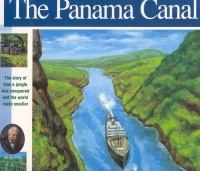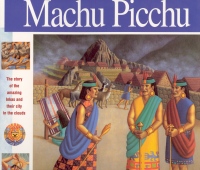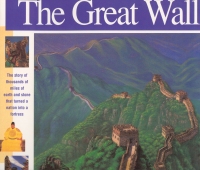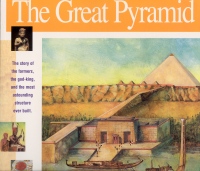| ________________
CM . . .
. Volume XIII Number 5 . . . .October 27, 2006 
 |
The Panama Canal. (Wonders of the World Book).
Elizabeth Mann. Illustrated by Alan Witschonke.
New York, NY: Miyaka Press (Distributed in Canada by Firefly Books), 1998/2006.
48 pp., pbk., $9.95.
ISBN 1-931414-14-9.
Subject Heading:
Panama Canal (Panama)-History-Juvenile literature.
Grades 4-8 / Ages 9-13.
Review by Gail Hamilton.
**** /4
|
| |
|
 |
Machu Picchu. (Wonders of the World Book).
Elizabeth Mann. Illustrated by Amy Crehore.
New York, NY: Miyaka Press (Distributed in Canada by Firefly Books), 2000/2006.
48 pp., pbk., $9.95.
ISBN 1-931414-10-6.
Subject Headings:
Machu Picchu Site (Peru)-Juvenile literature.
Incas-Juvenile literature.
Grades 4-8 / Ages 9-13.
Review by Gail Hamilton.
**** /4
|
| |
|
 |
The Great Wall. (Wonders of the World Book).
Elizabeth Mann. Illustrated by Alan Witschonke.
New York, NY: Miyaka Press (Distributed in Canada by Firefly Books), 1997/2006.
48 pp., pbk., $9.95.
ISBN 1-931414-12-2.
Subject Heading:
Great Wall of China (China)-Juvenile literature.
Grades 4-8 / Ages 9-13.
Review by Gail Hamilton.
**** /4
|
| |
|
 |
The Great Pyramid. (Wonders of the World Book).
Elizabeth Mann. Illustrated by Laura Lo Turco.
New York, NY: Miyaka Press (Distributed in Canada by Firefly Books), 1996/2006.
48 pp., pbk., $9.95.
ISBN 1-931414-11-4.
Subject Headings:
Great Pyramid (Egypt)-Juvenile literature.
Egypt-Civilization-To 322 B.C.-Juvenile literature.
Grades 4-8 / Ages 9-13.
Review by Gail Hamilton.
**** /4
|
| |
|

excerpt:
Five large boats were buried in the pits near the pyramid.
They were solar boats for Khufu’s ka to use in its daily voyage across the sky with the sun.
In 1954, one of the boat pits, hidden since the time of Khufu, was discovered. The boat inside was untouched. Before being buried, it had been taken apart, then all 1,244 pieces had been placed in careful layers in the pit like a gigantic model boat kit. It took ten years to put it back together. When it was finished, Khufu’s solar boat was 143 feet long. (From The Great Pyramid.)
Bound to capture the imaginations of readers, this award-winning series, entitled “Wonders of the World Books,” consists of nine titles. With her comfortable narrative writing style, Mann transports readers back in time and captures the flavour of the ancient civilizations and places about which she writes. The text is richly enhanced by the excellent illustrations - drawings, maps, and both colour and black-and-white archival photographs. Each book also has an index and a large fold-out section to show more detail of the featured structure. Two of the titles, Machu Picchu and The Great Pyramid, provide glossaries.
A masterpiece of engineering in a harsh terrain and climate, the Panama Canal was built at a monetary cost of $352 million and a human cost of 25,000 lives lost. Between 1904 and 1914, people from 68 different countries worked on this gargantuan project. The Panama Canal describes the design of the canal and how it works and traces the canal’s history, from Frenchman Ferdinand de Lessep’s failed attempt to bring the project to fruition- despite his success at building the Suez Canal- to U.S. President Theodore Roosevelt’s takeover of the project for the purpose of creating a shorter, easier route between oceans for American navy ships. Workers faced many obstacles, ranging from 130-degree temperatures to dense mountain jungle and dreaded tropical diseases. Living conditions divided American and Caribbean workers. While the Americans lived in comfortable housing and were paid high salaries and provided with free medical care, good food, education and social activities, the black Caribbean workers lived in jungle shacks and were paid far less than their American counterparts. However, despite the many hardships, the canal was completed six months ahead of schedule, and, on August 15th, 1914, the S.S. Ancon made the first official passage through the canal. Though its intended use as a shortcut for the U.S. Navy never really materialized, the tremendous economic boon to commercial shipping made the extraordinary construction effort worthwhile.
Discovered in July 1911, by Hiram Bingham, Machu Picchu was built by Pachacuti, mightiest of all Inca emperors, as a royal estate and religious center. Though overgrown with thick foliage at the time of Bingham’s discovery, the buildings were much the same as they had been in 1532. Because the Incas had no written language, much of what is known about their civilization is taken from the point-of-view of the Spanish, who recorded their observations on their voyages to South America. Machu Picchu focuses on the vast Incan empire, which had, at one time, as many as 10 million subjects. The Incas built roads, devised a census and a tax system and imposed their religion on the people. Pachacuti watched the sun, moon and stars to determine the exact placement of Machu Picchu and finally chose the site because of its being surrounded by sacred mountains and a river almost circling its entirety. In addition, the proximity of the rainforest gave the people access to coca leaves for religious ceremonies, brightly coloured bird feathers for decoration and herbs for healing. Mann describes the building process which involved moving gigantic stones, and stonemasons shaping the granite into blocks, some of which had at least 33 corners, that fit together to form walls. About 1000 people lived at Machu Picchu which consisted of homes, workshops, temples, plazas and agricultural areas. Supplies and food were brought from nearby farming communities and from the jungle. Though the Incas thrived for a time, the arrival of the Europeans decimated the Incan population with diseases to which the Incas had no immunity. Machu Picchu was abandoned before the Spanish arrived in the Andes.
After the first emperor of China built the first long wall to protect his empire from the Mongols, nomads considered “barbarians”, walls became a common form of defense. The Great Wall highlights the history of Mongol and Chinese rule from 1259 and the need for the Chinese to build huge walls of pounded earth - and, later, of bricks and stone blocks - to block Mongol routes through the mountain passes. An elaborate defense system, with signal towers built near the Great Wall, was designed to warn armies of Mongol sightings. Guards would send smoke signals from one tower to another in codes, the number of smoke plumes and cannon shots indicating the number of enemy riders approaching. A fold-out illustration in the book shows what an attack on the wall might have looked like. The book explains the wall’s construction, the hardships endured by the workers and the soldiers and the historical events which led up to the wall’s becoming unnecessary, its watch towers abandoned and its gates left open.
In 2550, Khufu became pharaoh of Egypt, and, following the tradition of the pharaohs who had preceded him, became the god Horus, on earth. Breaking with tradition later in his reign, he also became Re, the sun god. Khufu was an influential leader under whose power and guidance Egypt prospered. In preparation for the afterlife, he felt that, being the mightiest pharaoh, he had to build a tomb to match his stature. The Great Pyramid provides information about the tremendous undertaking of constructing this 50-story, 13-acre pyramid, built on solid limestone on a carefully chosen site, the Giza Plateau. Thousands of workers moved over 2,300,000 stone blocks to the site on sleds. Twenty-three years into Khufu’s reign, the pharaoh died and the 70-day mummification process - described in detail in the book - began. Khufu’s two sons subsequently served as pharaohs and had their tombs built on the Giza Plateau as well, though none of the tombs could rival their father’s. Today, little remains of the statues and jewellery in Khufu’s tomb - the burial chamber was plundered - but even after 45 centuries, the pyramid, the world’s most studied and photographed building, still stands. The author states that the book is based on “widely respected theories” and up-to-date archaeological evidence, but concedes that this is by no means the complete story, for new information is being learned every day.
Informative, entertaining, often riveting, these books offer readers important pieces of history and bring the civilizations to life through vivid detail, fascinating facts and engaging writing. A must-have series!
Highly Recommended.
Gail Hamilton is a teacher-librarian in Winnipeg, MB.

To comment
on this title or this review, send mail to cm@umanitoba.ca.
Copyright © the Manitoba Library Association. Reproduction for personal
use is permitted only if this copyright notice is maintained. Any
other reproduction is prohibited without permission.
NEXT REVIEW |
TABLE OF CONTENTS FOR THIS ISSUE
- October 27, 2006.
AUTHORS |
TITLES |
MEDIA REVIEWS |
PROFILES |
BACK ISSUES |
SEARCH |
CMARCHIVE |
HOME |



